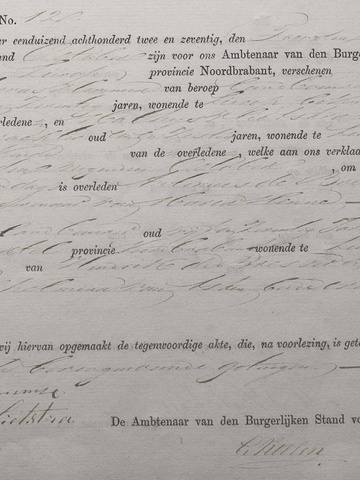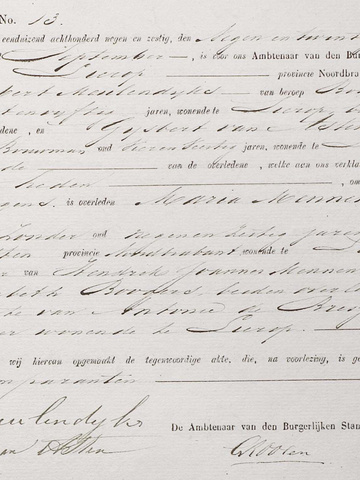Family Tree Bernard Hazenberg » Maria Moors (1864-1922)
Personal data Maria Moors
Sources 1, 2- She was born on September 7, 1864 in Lierop, Noord-Brabant, Nederland.
- Resident:
- Mierlo, Noord-Brabant, Nederland.
- Helmond, Noord-Brabant, Nederland.
- She died on August 19, 1922 in Mierlo, Noord-Brabant, Nederland, she was 57 years old.
- A child of Johannes Moors and Wilhelmina de Bresser
Household of Maria Moors
She is married to Martinus van Vugt.
They got married on August 17, 1903 at Mierlo, Noord-Brabant, Nederland, she was 38 years old.
Child(ren):
- Wilhelmina Lambertha Maria van Vugt 1904-1968
Timeline Maria Moors
This functionality is only available in Javascript supporting browsers.
Click on the names for more info.
Symbols used:  grandparents
grandparents
 parents
parents
 brothers/sisters
brothers/sisters
 children
children
 grandparents
grandparents
 parents
parents
 brothers/sisters
brothers/sisters
 children
children
Sources
- (Not public)
- (Not public)
Matches in other publications
This person also appears in the publication:Historical events
Birthday September 7, 1864
- The temperature on September 7, 1864 was about 16.9 °C. There was 3 mm of rain. The air pressure was 6 kgf/m2 and came mainly from the west-northwest. The airpressure was 76 cm mercury. The atmospheric humidity was 79%. Source: KNMI
- Koning Willem III (Huis van Oranje-Nassau) was from 1849 till 1890 sovereign of the Netherlands (also known as Koninkrijk der Nederlanden)
- In The Netherlands , there was from February 1, 1862 to February 10, 1866 the cabinet Thorbecke II, with Mr. J.R. Thorbecke (liberaal) as prime minister.
- In the year 1864: Source: Wikipedia
- The Netherlands had about 3.6 million citizens.
- February 29 » American Civil War: Kilpatrick–Dahlgren Raid fails: Plans to free 15,000 Union soldiers being held near Richmond, Virginia are thwarted.
- May 5 » American Civil War: The Battle of the Wilderness begins in Spotsylvania County.
- May 21 » Russia declares an end to the Russo-Circassian War and many Circassians are forced into exile. The day is designated the Circassian Day of Mourning.
- June 30 » U.S. President Abraham Lincoln grants Yosemite Valley to California for "public use, resort and recreation".
- July 28 » American Civil War: Battle of Ezra Church: Confederate troops make a third unsuccessful attempt to drive Union forces from Atlanta, Georgia.
- July 30 » American Civil War: Battle of the Crater: Union forces attempt to break Confederate lines at Petersburg, Virginia by exploding a large bomb under their trenches.
Day of marriage August 17, 1903
- The temperature on August 17, 1903 was between 10.8 °C and 16.8 °C and averaged 14.0 °C. There was 0.1 hours of sunshine (1%). Source: KNMI
- Koningin Wilhelmina (Huis van Oranje-Nassau) was from 1890 till 1948 sovereign of the Netherlands (also known as Koninkrijk der Nederlanden)
- In The Netherlands , there was from August 1, 1901 to August 16, 1905 the cabinet Kuijper, with Dr. A. Kuijper (AR) as prime minister.
- In the year 1903: Source: Wikipedia
- The Netherlands had about 5.3 million citizens.
- January 17 » El Yunque National Forest in Puerto Rico becomes part of the United States National Forest System as the Luquillo Forest Reserve.
- June 16 » Roald Amundsen leaves Oslo, Norway, to commence the first east–west navigation of the Northwest Passage.
- August 29 » The Slava, the last of the five Borodino-class battleships, is launched.
- September 27 » The Wreck of the Old 97, an American rail disaster that became the subject of a popular ballad.
- October 10 » The Women's Social and Political Union is founded in support of the enfranchisement of British women.
- November 17 » The Russian Social Democratic Labour Party splits into two groups: The Bolsheviks (Russian for "majority") and Mensheviks (Russian for "minority").
Day of death August 19, 1922
- The temperature on August 19, 1922 was between 7.7 °C and 20.3 °C and averaged 14.6 °C. There was 12.0 hours of sunshine (83%). The average windspeed was 3 Bft (moderate breeze) and was prevailing from the west. Source: KNMI
- Koningin Wilhelmina (Huis van Oranje-Nassau) was from 1890 till 1948 sovereign of the Netherlands (also known as Koninkrijk der Nederlanden)
- In The Netherlands , there was from September 9, 1918 to September 18, 1922 the cabinet Ruys de Beerenbrouck I, with Jonkheer mr. Ch.J.M. Ruys de Beerenbrouck (RKSP) as prime minister.
- In The Netherlands , there was from September 19, 1922 to August 4, 1925 the cabinet Ruys de Beerenbrouck II, with Jonkheer mr. Ch.J.M. Ruys de Beerenbrouck (RKSP) as prime minister.
- In the year 1922: Source: Wikipedia
- The Netherlands had about 7.0 million citizens.
- January 11 » First use of insulin to treat diabetes in a human patient.
- January 28 » Knickerbocker Storm, Washington D.C.'s biggest snowfall, causes the city's greatest loss of life when the roof of the Knickerbocker Theatre collapses.
- February 6 » The Washington Naval Treaty is signed in Washington, D.C., limiting the naval armaments of United States, Britain, Japan, France, and Italy.
- August 2 » A typhoon hits Shantou, Republic of China, killing more than 50,000 people.
- August 30 » Battle of Dumlupınar: The final battle in the Greco-Turkish War ("Turkish War of Independence").
- September 18 » The Kingdom of Hungary is admitted to the League of Nations.
Same birth/death day
- 1860 » Grandma Moses, American painter († 1961)
- 1862 » Edgar Speyer, American-English financier and philanthropist († 1932)
- 1866 » Tristan Bernard, French author and playwright († 1947)
- 1867 » Albert Bassermann, German-Swiss actor († 1952)
- 1867 » J. P. Morgan Jr., American banker and philanthropist († 1943)
- 1869 » Ben Viljoen, South African general († 1917)
- 1914 » Franz Xavier Wernz, German religious leader, 25th Superior General of the Society of Jesus (b. 1844)
- 1915 » Tevfik Fikret, Turkish poet and educator (b. 1867)
- 1923 » Vilfredo Pareto, Italian sociologist and economist (b. 1845)
- 1928 » Stephanos Skouloudis, Greek banker and diplomat, 97th Prime Minister of Greece (b. 1838)
- 1929 » Sergei Diaghilev, Russian critic and producer, founded Ballets Russes (b. 1872)
- 1932 » Louis Anquetin, French painter (b. 1861)
About the surname Moors
- View the information that Genealogie Online has about the surname Moors.
- Check the information Open Archives has about Moors.
- Check the Wie (onder)zoekt wie? register to see who is (re)searching Moors.
The Family Tree Bernard Hazenberg publication was prepared by B. Hazenberg.
When copying data from this family tree, please include a reference to the origin:
B. Hazenberg, "Family Tree Bernard Hazenberg", database, Genealogy Online (https://www.genealogieonline.nl/family-tree-bernard-hazenberg/I506119.php : accessed August 9, 2025), "Maria Moors (1864-1922)".
B. Hazenberg, "Family Tree Bernard Hazenberg", database, Genealogy Online (https://www.genealogieonline.nl/family-tree-bernard-hazenberg/I506119.php : accessed August 9, 2025), "Maria Moors (1864-1922)".



